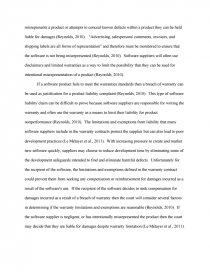Software Liability
Essay by Marry • August 21, 2011 • Research Paper • 672 Words (3 Pages) • 1,376 Views
Pressure to complete the development and testing phase of software development quickly leads some suppliers to act unethically 'cutting corners' and eliminating development methods that are intended to find and correct software defects. Fortunately for consumers, if the supplier fails to follow acceptable development methods and protocols, they can sue for damages incurred as a result of the supplier's negligence. Software liability claims based can be based on negligence if they fail to find and correct harmful software defects that could have been found if they followed "reasonable software development practices" (Reynolds, 2010). The defendant in the case is liable for any harmful effects of the defaults or problems with the software unless they can justify their behavior or prove that the plaintiff's actions or use of the software was partially responsible for the damages (Reynolds, 2010).
If the consumer feels that a negligence based case would be difficult to prove then they can file a complaint based on the concept of strict liability. If the plaintiff in a software liability case can prove that the software is defective and causes unreasonable dangers than a software liability claim can file a strict liability case (Reynolds, 2010). In this type of case the consumer only has to prove that damages occurred as a result of using the product, they do not have to prove that the company was negligent or intentionally concealed the defect responsible for the damages (Reynolds, 2010). In order to pursue a strict liability claim the plaintiff must have followed the products specifications and cannot have altered the software after they received it (Reynolds, 2010). There is also a limit on the amount of time the plaintiff has to file the claim once the injury has occurred (Reynolds, 2010).
Under pressure to deliver software quickly and cost effectively, suppliers must decide if they are going to spend the time and money to correct defects or if they are going to attempt to conceal the defect in order to get the software onto the market. If a software suppliers knowingly misrepresents a product or attempts to conceal known defects within a product they can be held liable for damages (Reynolds, 2010). "Advertising, salespersons' comments, invoices, and shipping labels are all forms of representation" and therefore must be monitored to ensure that the software is not being misrepresented (Reynolds, 2010). Software suppliers will often use disclaimers and limited warranties as a way to limit the possibility that they can be sued for intentional misrepresentation of a product (Reynolds, 2010).
If a software product fails to meet the warranties standards then a breach of warranty can be used as justification for a product liability complaint (Reynolds, 2010). This type of software liability claim can be difficult to prove because software suppliers are responsible
...
...

